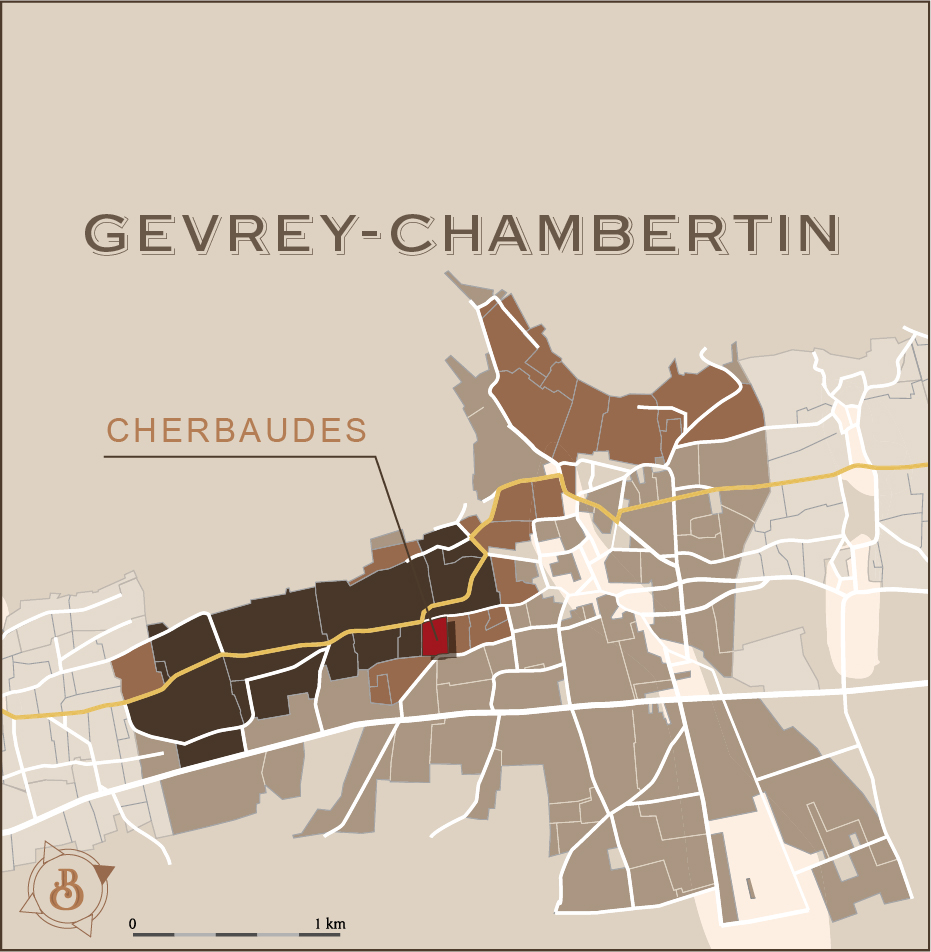Gevrey-Chambertin
1er Cru Cherbaudes 2019
The name has prestigious overtones; the location is one of the noblest imaginable. The very least one can say is that Gevrey-Chambertin is where the Grands Crus of the Burgundy Côte really begin…
Origin
For travellers coming from Dijon, Gevrey-Chambertin is where Burgundy’s Elysian Fields begin. At the entrance to the hollowed hill of Lavaux, a château -once a property of the monks of Cluny - resembles a fortified wine-cellar. The canons of Langres, too, were for a long time guardians of these vineyards which can be dated back to the year 640 AD, evidence of a long and intimate involvement in the history of Burgundy's wine industry. Gevrey-Chambertin forms a kind of guard of honour to a set of fabulous Grands Crus whose crown jewels are Chambertin and Clos de Bèze. The appellation dates from September 1936. The village of Brochon is an extension of Gevrey-Chambertin, sharing the same characteristics. The Pinot Noir is at its peak performance here.
"Les Cherbaudes" is a small plot of 2 ha, classified as Premier Cru. Its neighbors are Mazis-Chambertin, Chambertin and Chapelle-Chambertin ... This climat name comes from an ancient 'Chenevière', that is the land where hemp was cultivated. Culture developed in Burgundy since the Middle Ages and which was still called in the 16th century Chèrebaud.
Viticulture
Grape variety: pinot noir
Soils: shallow, brown in color with limestone pebbles.
Orientation: South-East
Surface area under vine: 0.1420 ha
Pruning: Guyot system
Yield: 41 hL/ha
Average age of the vines: 45 years old.
Vinification
Harvest date: 24 September 2019.
The grapes were handpicked. First sorting in the vineyard, second on the sorting table upon receipt of the harvest.
At the winery: 50% of grapes were destemmed but not crushed (they were left whole) and were gravity-fed into tanks. Maceration with 50% whole bunches lasted a total of 22 days including 2 days of cold maceration (12°C). Fermentation used indigenous yeasts only (no additives such as enzymes or tannins were used). 2 punchings of the cap.
Ageing
Maturation: aged on the lees for 16 months with no racking using a proportion of 50% new French oak barrels.
Barrels: French oak barrels that had been toasted at low temperatures for a long time for very delicate oaking.
Bottling
Bottling: the wine was not fined but was very gently filtered before being bottled using gravity in March 2021.
Number of bottles: 775.
Vintage
A legendary vintage?
According to Grégory Patriat, this second harvest at the Ursulines winery will go down as a legendary vintage just like 1969, 1979, 1999, 2009, and 2019, because the concentration in the wines is very high indeed. Years with drought and low yields are always great vintages in Burgundy. We had some new premier crus come online last year, with three in Chambolle-Musigny, one in Gevrey-Chambertin, and one in Nuits-Saint-Georges; Le Clos des Argillères. Furthermore, we revived our tradition of producing white wines in villages better known for their reds, with a white Fixin.
Ageing potential: 7 years and more.
Tasting notes
The color is garnet red. The nose is very expressive with intense aromas of small red fruits but also of plums with subtly spicy notes. Powerful, long in the mouth, its structure is concentrated with a beautiful tannic substance.



